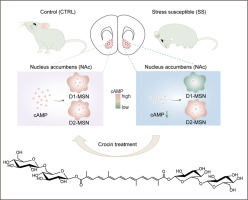Keywords
cAMP
Nucleus accumbens
Depression
D1-MSN
D2-MSN
Rapid antidepressant
Crocin
Ketamine
© 2023 Published by Elsevier B.V. on behalf of Chinese Pharmaceutical Association and Institute of Materia Medica, Chinese Academy of Medical Sciences.

Studies have suggested that the nucleus accumbens (NAc) is implicated in the pathophysiology of major depression; however, the regulatory strategy that targets the NAc to achieve an exclusive and outstanding anti-depression benefit has not been elucidated. Here, we identified a specific reduction of cyclic adenosine monophosphate (cAMP) in the subset of dopamine D1 receptor medium spiny neurons (D1-MSNs) in the NAc that promoted stress susceptibility, while the stimulation of cAMP production in NAc D1-MSNs efficiently rescued depression-like behaviors. Ketamine treatment enhanced cAMP both in D1-MSNs and dopamine D2 receptor medium spiny neurons (D2-MSNs) of depressed mice, however, the rapid antidepressant effect of ketamine solely depended on elevating cAMP in NAc D1-MSNs. We discovered that a higher dose of crocin markedly increased cAMP in the NAc and consistently relieved depression 24 h after oral administration, but not a lower dose. The fast onset property of crocin was verified through multicenter studies. Moreover, crocin specifically targeted at D1-MSN cAMP signaling in the NAc to relieve depression and had no effect on D2-MSN. These findings characterize a new strategy to achieve an exclusive and outstanding anti-depression benefit by elevating cAMP in D1-MSNs in the NAc, and provide a potential rapid antidepressant drug candidate, crocin.
cAMP
Nucleus accumbens
Depression
D1-MSN
D2-MSN
Rapid antidepressant
Crocin
Ketamine
© 2023 Published by Elsevier B.V. on behalf of Chinese Pharmaceutical Association and Institute of Materia Medica, Chinese Academy of Medical Sciences.
Add Comment